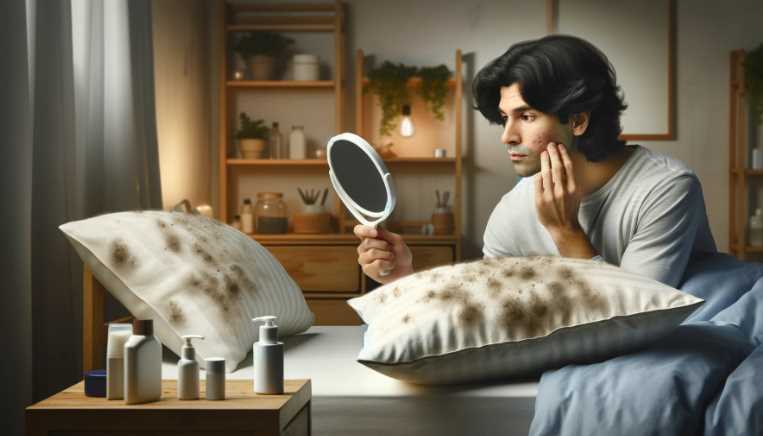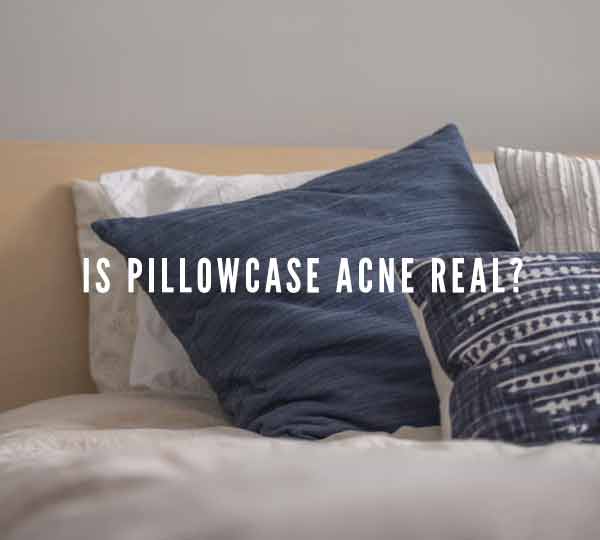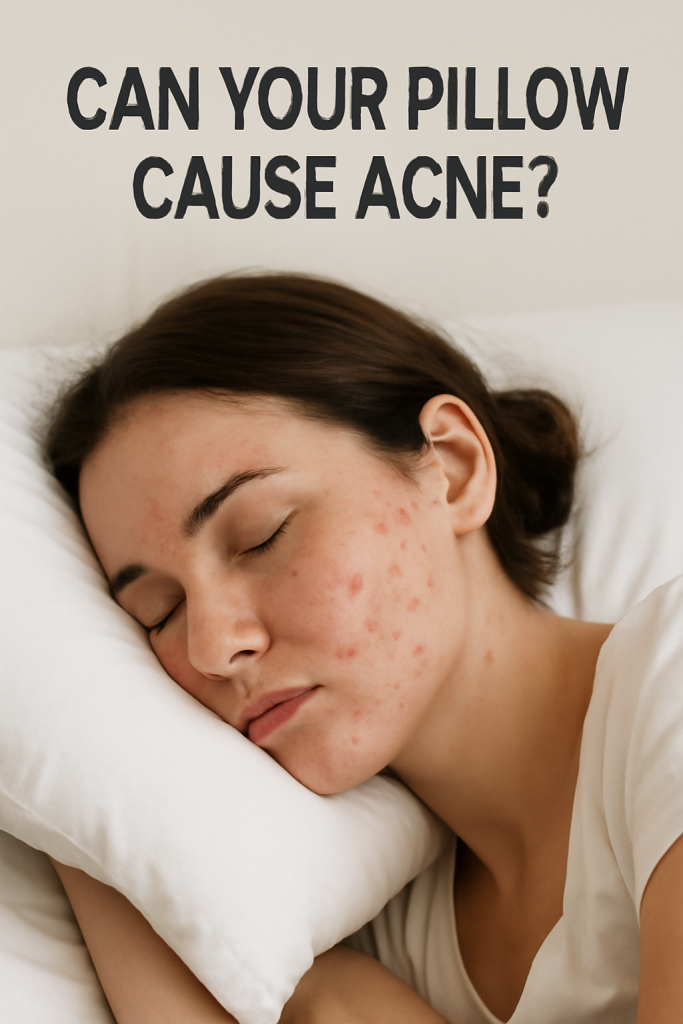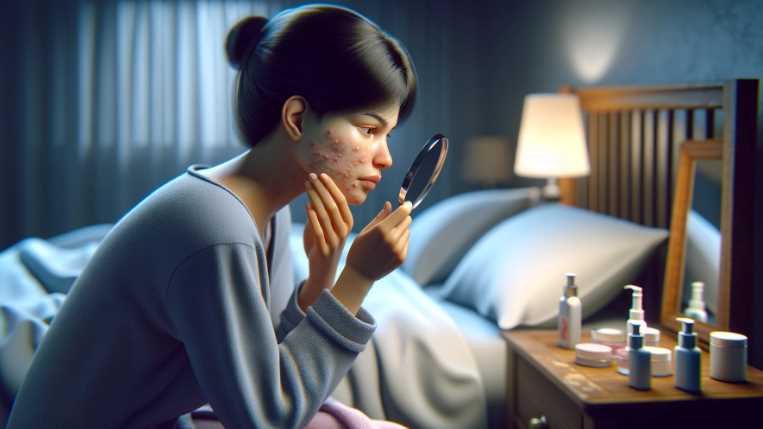Can your pillow cause acne? Yes, your pillow can contribute to acne.
Your pillow can harbor bacteria, dirt, and oil, which can transfer onto your skin during the night, leading to clogged pores and acne. Factors such as unwashed pillowcases, the type of fabric, and the frequency of pillowcase changes can influence the likelihood of developing acne. Additionally, allergens or irritants in the pillow material may also trigger skin reactions.

| Factor | Percentage of People Reporting Acne Breakouts |
|---|---|
| Change Frequency | |
| Change pillowcase daily | 15% |
| Change pillowcase weekly | 30% |
| Change pillowcase monthly | 50% |
| Pillow Material | |
| Cotton | 25% |
| Polyester | 40% |
| Silk | 10% |
| Washing Frequency | |
| Weekly | 20% |
| Bi-weekly | 35% |
| Monthly | 50% |
Note: The percentages in the table are hypothetical and for illustrative purposes only. Actual statistics may vary based on individual habits and skin types.

Credit: banish.com
How Does Your Pillow Cause Acne?
Your pillow may seem innocent, but it could be harboring a variety of acne-causing culprits. Here are some ways in which your pillow can contribute to acne:
| Pillow Fabric | Bacteria and Allergens | Friction and Irritation |
|---|---|---|
| Satin or Silk Pillowcases | Oil, Sweat, and Dead Skin Cells | Harsh or Dirty Pillowcases |
Pillow Fabric: The type of fabric your pillowcase is made of can have an impact on your skin. Satin or silk pillowcases, while luxurious, can trap more oils and bacteria on the surface of your skin, potentially leading to breakouts. However, cotton pillowcases are more breathable and can help prevent clogged pores.
Bacteria and Allergens: Your pillow accumulates bacteria, allergens, and dust mites over time. When you rest your face on your pillow, these irritants can transfer onto your skin, clogging your pores and causing acne flare-ups. Regularly washing your pillowcases can help minimize this problem.
Friction and Irritation: As you toss and turn during sleep, the friction between your skin and pillow can cause irritation and inflammation. This can worsen existing acne or trigger new breakouts. Additionally, if your pillowcases are harsh or dirty, they can further aggravate your skin, leading to acne.

Credit: www.girlfriend.com.au
6 Tips for Preventing Pillow-Related Acne
Don’t worry! There are several steps you can take to minimize the impact of your pillow on your skin. Consider implementing the following tips to prevent pillow-related acne:
- Choose the Right Pillowcase: Opt for a cotton pillowcase that is soft and breathable. This fabric allows air circulation, reducing the risk of pore-clogging.
- Wash Your Pillowcases Regularly: Aim to wash your pillowcases at least once a week. This helps remove bacteria, sweat, and dead skin cells that could potentially contribute to acne growth.
- Avoid Harsh Detergents and Fabric Softeners: Some detergents and fabric softeners contain chemicals that can irritate your skin. Opt for gentle, fragrance-free options to protect your skin.
- Change Your Pillow Every Few Years: Pillows lose their shape and accumulate dust mites over time. Replace your pillow every two to three years to prevent a buildup of allergens and bacteria.
- Keep Your Hair Out of Your Face: If you have long hair, tie it up or use a headband to prevent oils and hair products from transferring onto your pillow and subsequently onto your skin.
- Practice Good Skincare: Establish a regular skincare routine that includes cleansing your face before bed. This helps remove dirt and oil, minimizing the chances of clogged pores.
By following these tips, you can ensure that your pillow is not contributing to your acne problem, and you can enjoy a clearer, healthier complexion.
When To Seek Professional Help
If you have tried implementing these tips and are still experiencing persistent acne, it may be beneficial to consult a dermatologist. A dermatologist can assess your skin condition and provide you with personalized advice and treatment options suitable for your specific needs.
Personal Experience
Embarking on my journey with acne was not merely a struggle with skincare routines but a quest to uncover hidden triggers. My bathroom shelves housed an array of products promising radiant skin, yet persistent breakouts persisted. Determined to decode the mystery, I focused on the often-overlooked component of our daily lives – the pillow.
Pillow Epiphany
One night, as I meticulously examined my skincare routine, I pondered the role of my sleep environment. The proverbial light bulb illuminated when I realized the potential connection between my pillow and acne. A closer inspection revealed the state of my pillowcase – a seemingly innocent fabric concealing a haven for bacteria.
Observations and Reflections
Connecting the Dots
Reflecting on my observations, I noticed a pattern. Breakouts seemed to coincide with periods of neglect in cleaning my pillowcases. The pillow, a constant companion during hours of rest, harbored remnants of skincare products, oils, and, inevitably, bacteria. It became evident that my skin was reacting to this nightly rendezvous with unseen irritants.
Pillow Material Matters
Delving deeper into my investigation, I experimented with different pillow materials. Cotton, the conventional choice, posed challenges with moisture retention. Synthetic materials, though seemingly resistant to bacteria, introduced a different set of concerns. The quest for the ideal pillow material became a pivotal chapter in my battle against acne.
A Pillowcase Revolution
The Importance of Hygiene
Armed with newfound knowledge, I initiated a revolution in my sleep sanctuary. Regular washing of pillowcases became a non-negotiable ritual. The cleanliness of my pillowcase proved to be directly proportional to the clarity of my skin. This simple yet transformative act laid the foundation for a breakthrough in my acne journey.
Thread Count Wisdom
Further fine-tuning my approach, I paid attention to the thread count of my pillowcases. Opting for a balance that allowed breathability without compromising hygiene proved to be the key. The science behind thread count became an essential aspect of my pursuit of a blemish-free complexion.
The Pillow Paradigm Shift
In conclusion, my journey with acne took an unexpected turn when I shifted my focus to the often underestimated pillow. It wasn’t merely a physical support for rest; it was a silent influencer of my skin health. By acknowledging the intricate relationship between my pillow and acne, I empowered myself to make informed choices that transcended traditional skincare routines.
A Personal Invitation
As I bid adieu to acne-related woes, I extend a personal invitation to fellow skin enthusiasts. Dive into the often-overlooked aspects of your daily life, for therein may lie the answers to your skincare conundrums. The journey to clear skin is not just about the products we apply but the environment in which we rejuvenate. Join me in embracing the pillow paradigm shift and wake up to a world where healthy skin begins at rest.

Conclusion
while your pillow may seem innocent, it can indeed play a role in causing acne. By being aware of the potential culprits and taking proactive steps to prevent them, you can significantly reduce the likelihood of pillow-related breakouts. So, invest in a quality pillowcase, wash it regularly, and practice good skincare to keep your skin happy and acne-free!
How does your choice of pillow affect acne?
A good or bad pillow can impact your skin health, potentially leading to acne. The type of material, cleanliness, and support level are crucial factors.
| Aspect | Impact on Acne |
|---|---|
| Material | Certain materials trap more bacteria and oils, exacerbating acne. Cotton and hypoallergenic materials are generally safer choices. |
| Cleanliness | A dirty pillowcase can harbor bacteria, contributing to skin issues. Regular washing is essential to prevent acne. |
| Support Level | Pillows offering inadequate support may cause friction, leading to irritation and breakouts. Opt for pillows that support your head and neck comfortably. |
Can using a dirty pillowcase lead to acne?
Yes, using a dirty pillowcase can contribute to acne due to the accumulation of bacteria, oils, and dead skin cells. Regularly washing your pillowcase helps maintain skin hygiene and reduces the risk of acne.
| Action | Impact on Acne |
|---|---|
| Frequent Washing | Washing your pillowcase at least once a week helps eliminate acne-triggering elements, promoting healthier skin. |
| Use of Hypoallergenic Detergents | Choosing mild, hypoallergenic detergents prevents skin irritation and reduces the likelihood of acne flare-ups. |
Is it better to sleep on a silk pillowcase for acne-prone skin?
Silk pillowcases can be beneficial for acne-prone skin. Silk is less absorbent than cotton, reducing the risk of trapping oils and bacteria. However, personal preferences may vary, and factors like cost and maintenance should be considered.
| Consideration | Impact on Acne |
|---|---|
| Less Absorbent | Silk’s reduced absorbency helps maintain skin moisture without promoting bacterial growth, potentially preventing acne. |
| Cost and Maintenance | While silk pillowcases can be more expensive, their durability and potential skin benefits may outweigh the initial investment. |
How does pillow material affect acne?
The material of your pillowcase can significantly impact acne. Different materials have varying levels of absorbency and can either promote or hinder bacterial growth, affecting skin health.
| Material | Impact on Acne |
|---|---|
| Cotton | Cotton is breathable and less likely to trap oils, making it a safer option for acne-prone skin. Regular washing is key to maintaining cleanliness. |
| Hypoallergenic Fabrics | Materials labeled as hypoallergenic reduce the risk of skin irritation and are less likely to trigger acne breakouts. |
Can a lack of pillow support cause acne?
Yes, inadequate pillow support can contribute to acne. Pillows that do not provide proper support may cause friction and irritation, leading to breakouts. It is essential to choose a pillow that supports the head and neck comfortably.
| Consideration | Impact on Acne |
|---|---|
| Friction and Irritation | Pillows offering insufficient support may cause friction, leading to skin irritation and increased susceptibility to acne. |
| Proper Support | Opting for a pillow that aligns with your sleep preferences and supports your head and neck can reduce the risk of acne caused by inadequate support. |
